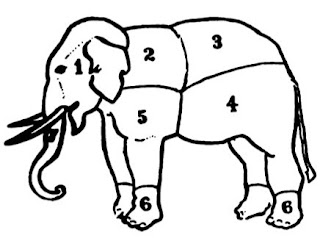While researching
the Menu Decoder, we found ourselves looking into a lot of early cookbooks.
They’re good fun, and they can give insights into the past—the people’s past,
the story of everyday life—that no formal history can. Over the last few years
some good people have been putting many old texts online, in the original
languages and sometimes even in English translation.
Today
we offer a tribute to our forebear Maestro Martino da Como, the author of one
of the first printed cookbooks, the Libro de Arte Coquinaria. Martino was a boy from a small village in the Swiss-Italian Canton
Ticino who worked his way up cooking for princes and prelates, counts and condottieri, and eventually ran the kitchens of the Pope.
Martino lived in
interesting times. When he was busy at his cookbook, in the 1460’s, Cosimo de’
Medici and Francesco Sforza ruled in Florence and Milan, and Italy was getting
its first printing press. Pope Nicholas V statyed up nights planning the
rebuilding of Rome, and the terrible Turk was making himself at home in
newly-captured Constantinople.
They were good
times too, especially for anyone with a skill to offer Renaissance Italy’s sophisticated
elite. Consumption then could be very conspicuous indeed, and Martino had the
talent for coming up with unique culinary spectaculars. One recipe in the De
Arte informs us ‘How to Dress a Peacock With All
Its Feathers, So that When Cooked, It Appears To Be Alive and Spews Fire From
Its Beak’.
Italian cooking
has always had its divisions of class. One thing you won’t find in De Arte is
onions. Not much garlic either; as the Maestro frankly explains: ’Garlic and
onions are good for the peasants, who eat them willingly and depend on them
because of their poverty and because of the work they do’.
Surprisingly
though, many of the recipes he chose to include are simple, even humble: porchetta and sausages, cockscombs, peas and beans—even pastine in brodo. Not so long ago, every trattoria in Italy still had this modest dish on the
menu—plain broth with nothing but tiny noodles in it, mostly for people whose
digestion was telling them to leave the pasta alone that day. Five hundred years ago, Martino was
cooking it for the princes of the Church.
We like his idea of putting a pinch of saffron in the broth. We’re not
so sure about his recommendation to boil the noodles for a full hour—it seems
in Martino’s kitchen there was always a whole lot of boiling going on.
De Arte has its quirks; the casualness of his approach seems charming to a modern
cook: ‘To cook an egg, let it boil for the time it takes to say an Our Father’—per
spatio d’un paternostro. Precise quantities are
hardly if ever given. We cooks are invited to use secundo che pare a la tua
discrezione—‘as much as we think best’. He’ll tell
us to put in ‘the good spices’ but never says which ones they are.
Maestro Martino
certainly would have enjoyed a longer spice rack than most other cooks in his
day, but any upper-crust kitchen would have had saffron, ginger, mace, cumin,
nutmeg and the lemony peppery spice called ‘grains of paradise’ (or maniguette to the French, who once were very fond of it), as well as most of
the common garden herbs we know today.
Martino had an
interesting palette of flavours. The great chef is said to have spent some
early days in Naples, and there is definitely a sweet hint of the south in many
of his recipes: plenty of almonds and almond milk, as well as raisins and other
dried fruits. Another star ingredient is agresto
(verjuice), prominent in many soups and sauces. People in the Renaissance liked
a touch of tartness in their dinner more than in later ages. Verjuice is the
squeezings of unripe grapes, a kinder, gentler sort of vinegar. Maybe it’s time for this old favourite to
make a comeback; if you have a lot of grapes, there’s a recipe for making it
here.
Anyone with the
time to go through De Arte will find plenty of
fascinating sidelights and surprises. If you thought cheesecake was a modern
innovation you’ll see a perfectly serviceable recipe for it here: torta
bianca, made with lots of ricotta and flavoured
with ginger and rosewater. There are cheesecake variants too, including one
that calls for a pound of garlic (!)
Maestro Martino’s
work lived on for centuries. Later editions, some good and some pennydreadfuls,
added whatever they pleased to the original recipes. One even included
(entirely fantastical) instructions on carving and cooking an elephant:
You can see the
whole text of De Arte Coquinaria here (in Italian) .
And a few of his recipes have been translated into English here.
There is also an English translation in print, though a flawed and
controversial one.
Online resources
are getting better all the time, and anyone with an interest in old recipes, or
anything else Italian, will be delighted to see John Florio’s 1611
English-Italian dictionary reproduced in a beautiful facsimile copy (thanks, Greg Lindahl!). Florio, a born
Londoner, was the son of an Italian refugee who became a great scholar and a
friend of Shakespeare; he spied on the French ambassador for Walsingham, and
did much to introduce the English to the arts and manners of Italy. For words
where Florio is no help, try the massive Tesoro della Lingua Italia delle Origini, a dictionary of Italian words going back
to the Middle Ages



No comments:
Post a Comment